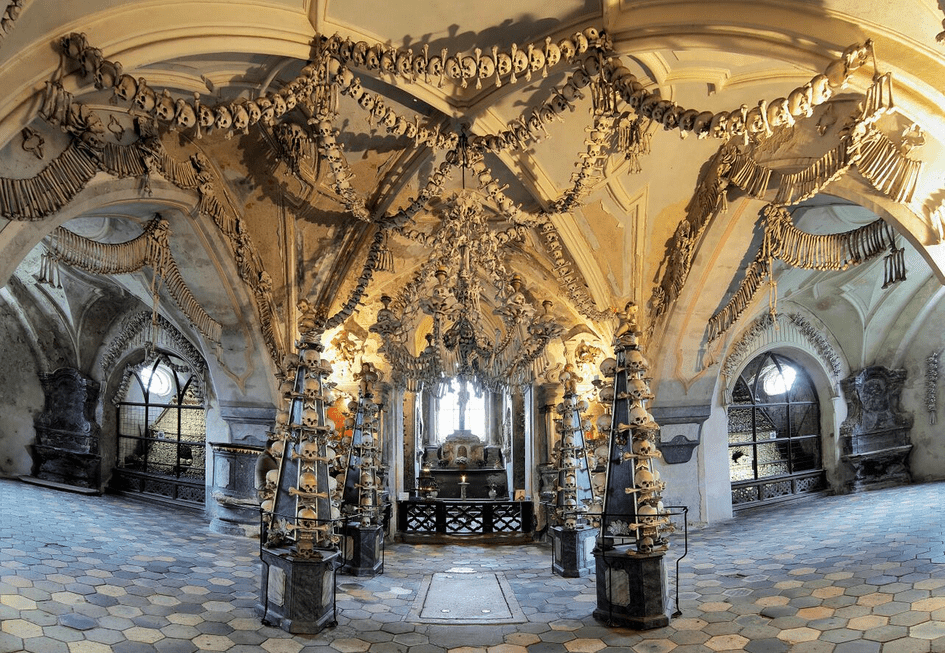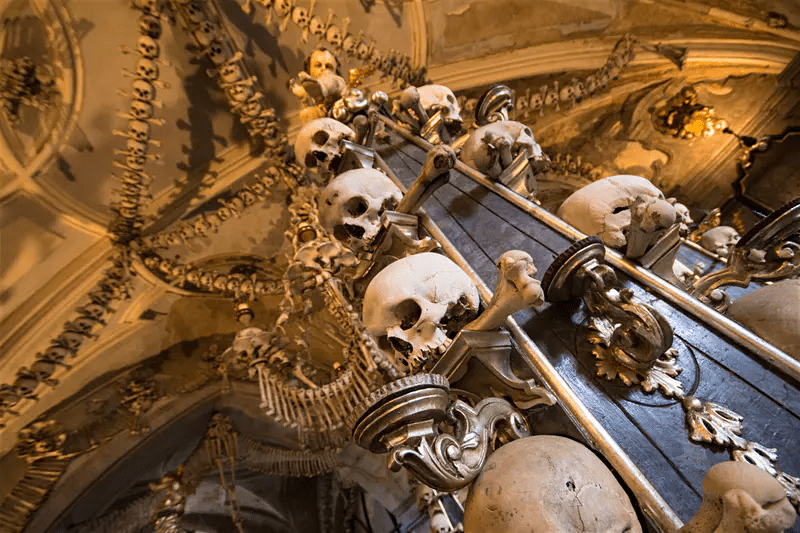Introduction to the Sedlec Ossuary
The Sedlec Ossuary, located in the small town of Kutná Hora in the Czech Republic, is one of Europe’s most unusual and fascinating tourist destinations. Popularly known as the “Bone Church,” this small underground chapel is world-renowned for its macabre interior decoration made entirely of human bones. The chapel is part of a small cemetery that was once one of the most coveted burial sites in Europe because it was sprinkled with soil brought from the Holy Sepulchre in Jerusalem.
A visit to the Ossuary is not only an encounter with the religious and cultural history of the region but also with a unique work of art created from the remains of approximately 40,000 people. This site attracts not only those interested in history and sacred art but also those curious about the macabre and the unusual.
The Ossuary is located in the Sedlec suburb of Kutná Hora, a city that flourished in the Middle Ages thanks to its silver mines. Today, Kutná Hora and the Sedlec Ossuary are included on the UNESCO World Heritage list, not only for their historical and cultural value but also for the impressive architecture that tells the richness and importance of this place in Czech history.
The decoration of the Ossuary is impressively detailed. Human bones are artistically arranged; from chandeliers and the Schwarzenberg family coat of arms to a huge bone spider hanging from the center of the ceiling. Each piece has been carefully designed to convey both respect and awe toward life and death.

History of the Sedlec Ossuary
The origins of the Sedlec Ossuary date back to the 13th century when an abbot of the local Cistercian monastery brought a handful of holy soil from Golgotha, the site of Jesus’ crucifixion in Jerusalem, to Sedlec. This action made the abbey cemetery one of the most desired burial places among the faithful of Central and Eastern Europe. During the Black Death epidemics in the 14th century and the Hussite wars in the 15th century, the number of burials increased significantly, causing the space to become insufficient.
To address this lack of space, a Gothic chapel with an underground crypt was built on the site at the end of the 15th century. In 1511, a blind monk from the monastery was tasked with exhuming the skeletons and stacking the bones in the crypt, a practical but temporary solution to the cemetery’s overcrowding.
The current arrangement of the bones, however, is attributed to František Rint, a Czech woodcarver hired by the Schwarzenberg family in 1870 to organize the piles of bones. Rint went beyond mere organization; he transformed the bones into art, using carving techniques to create ornaments and sculptures. Among his most notable creations are the central chandelier, which contains at least one example of each human bone, and the aforementioned replica of the Schwarzenberg coat of arms.
The fame of the Ossuary grew during the 19th and 20th centuries, becoming a symbol not only of death but also of equality in the face of it. This site invites reflection on the impermanence and universality of the human experience, regardless of social status.
In the 21st century, the Sedlec Ossuary continues to attract thousands of visitors annually, fascinated by its macabre beauty as well as its deep cultural and spiritual significance. Its maintenance and preservation are priorities for the community and authorities of Kutná Hora, ensuring that this cultural heritage continues to share its lesson of humility and reflection with future generations.

How to Get to the Ossuary from Prague
Visiting the Sedlec Ossuary from Prague is a simple and accessible excursion, ideal for those who wish to explore beyond the Czech capital. Given Kutná Hora’s proximity to Prague, travelers can choose from various modes of transport, each offering a different experience.
By train: The most popular option is to take the train from Prague’s main station, Praha hlavní nádraží. There are direct services that take you to Kutná Hora station in about an hour. Once in Kutná Hora, you can take a local train to Kutná Hora-Sedlec station, which is just a few minutes from the Ossuary. The station is a short walk from the Ossuary, making this mode of transport one of the most convenient and economical.
By bus: Another alternative is the bus, which departs from the Florenc bus station in Prague. Although the trip may be a bit longer than the train, it is equally efficient. Buses arrive at Kutná Hora’s central bus station, from where you can take a taxi or a local bus to the Ossuary.
By car: For those who prefer a more private option, renting a car is an excellent choice. The drive from Prague takes about an hour and a half, depending on traffic. This allows total flexibility in terms of schedules and the possibility of exploring other sites of interest in the region at your own pace.
Organized tours: Finally, numerous agencies in Prague offer day trips to the Sedlec Ossuary and Kutná Hora, including transportation and a guide. This option is ideal for those who prefer a guided and hassle-free experience.
Each transport option offers a different way to experience the journey from Prague to the Sedlec Ossuary, allowing visitors to choose according to their preferences and needs.
This flexibility makes visiting the Sedlec Ossuary an easy and enriching addition to any travel itinerary in the Czech Republic. More places to visit in Czech Republic in this article.
